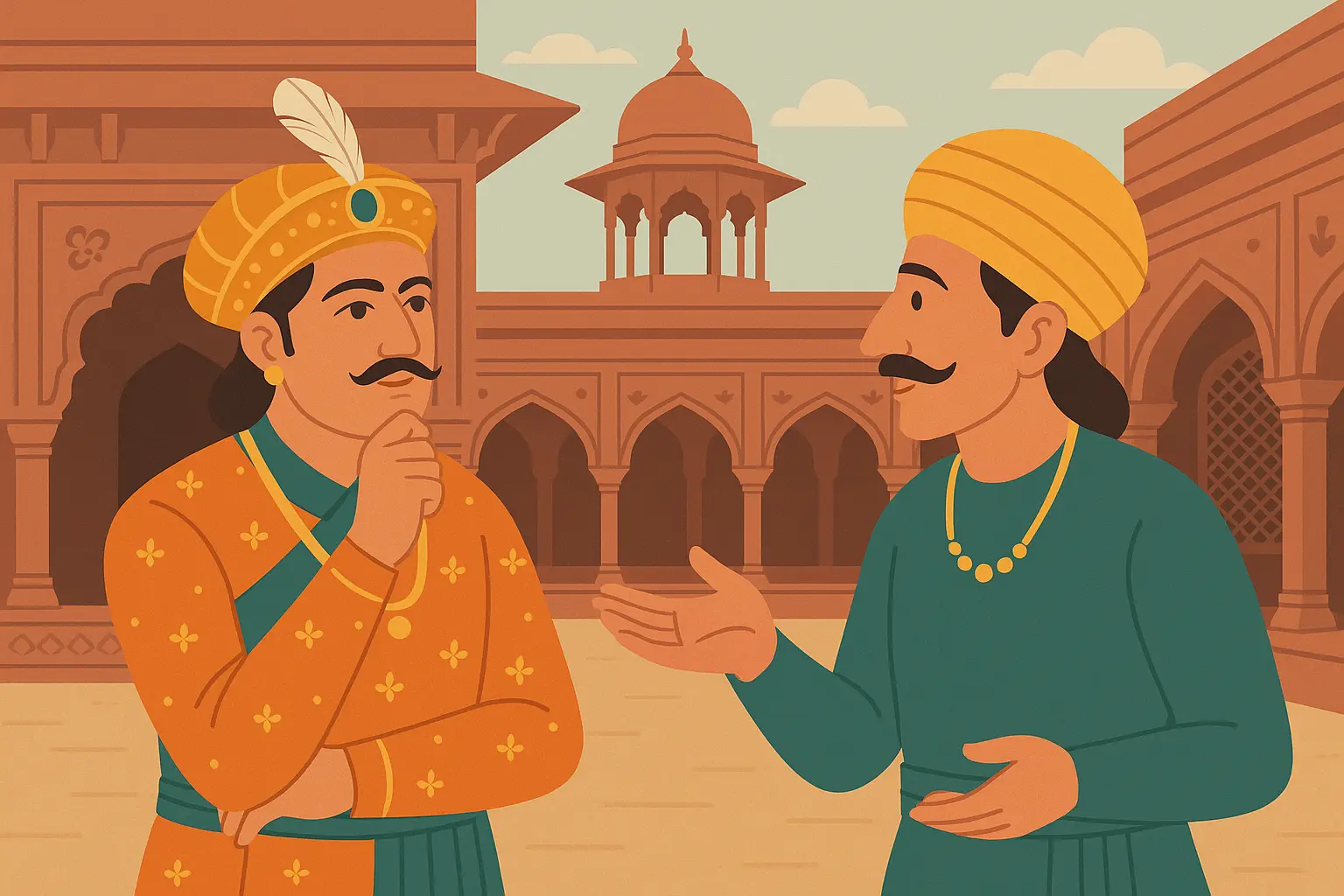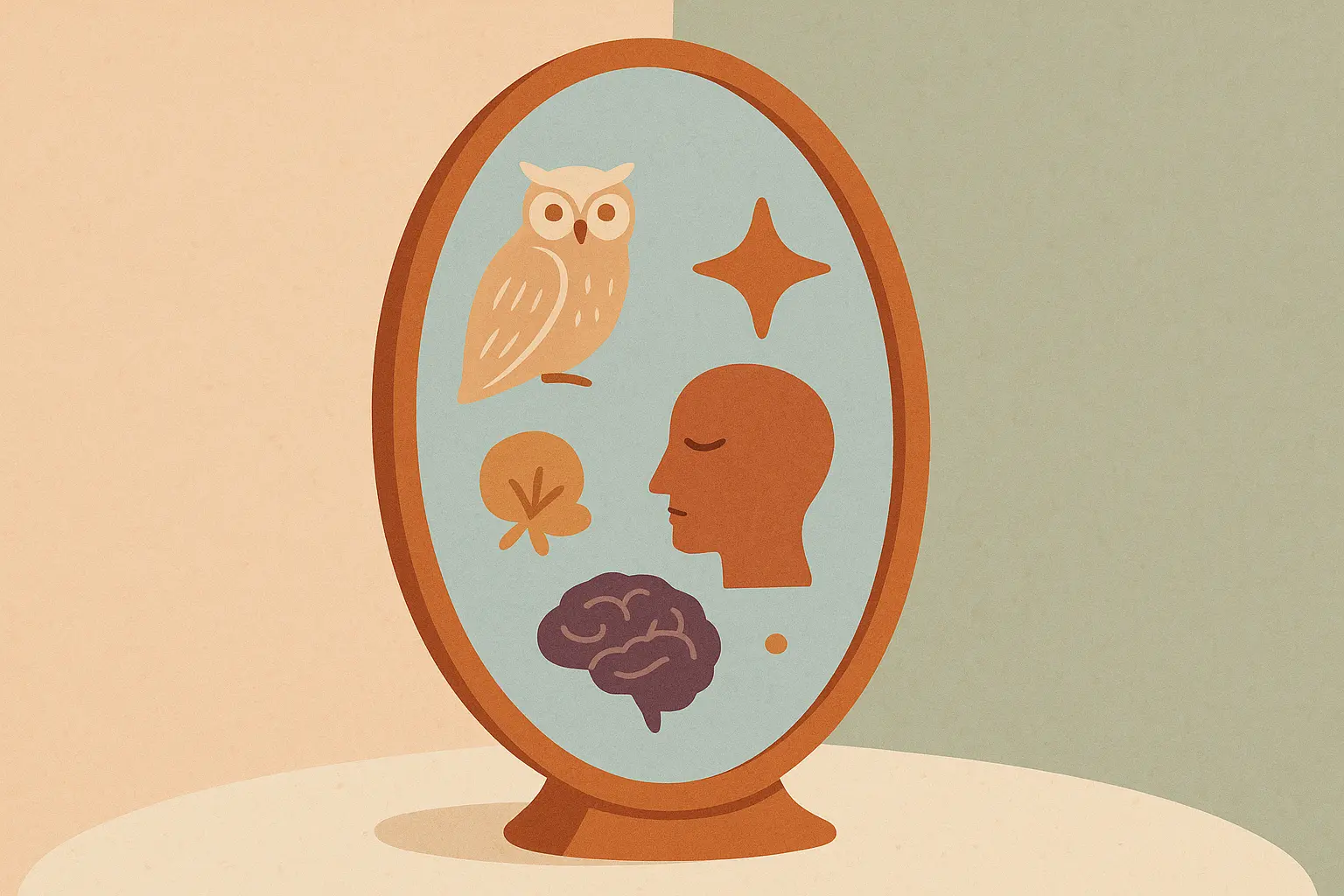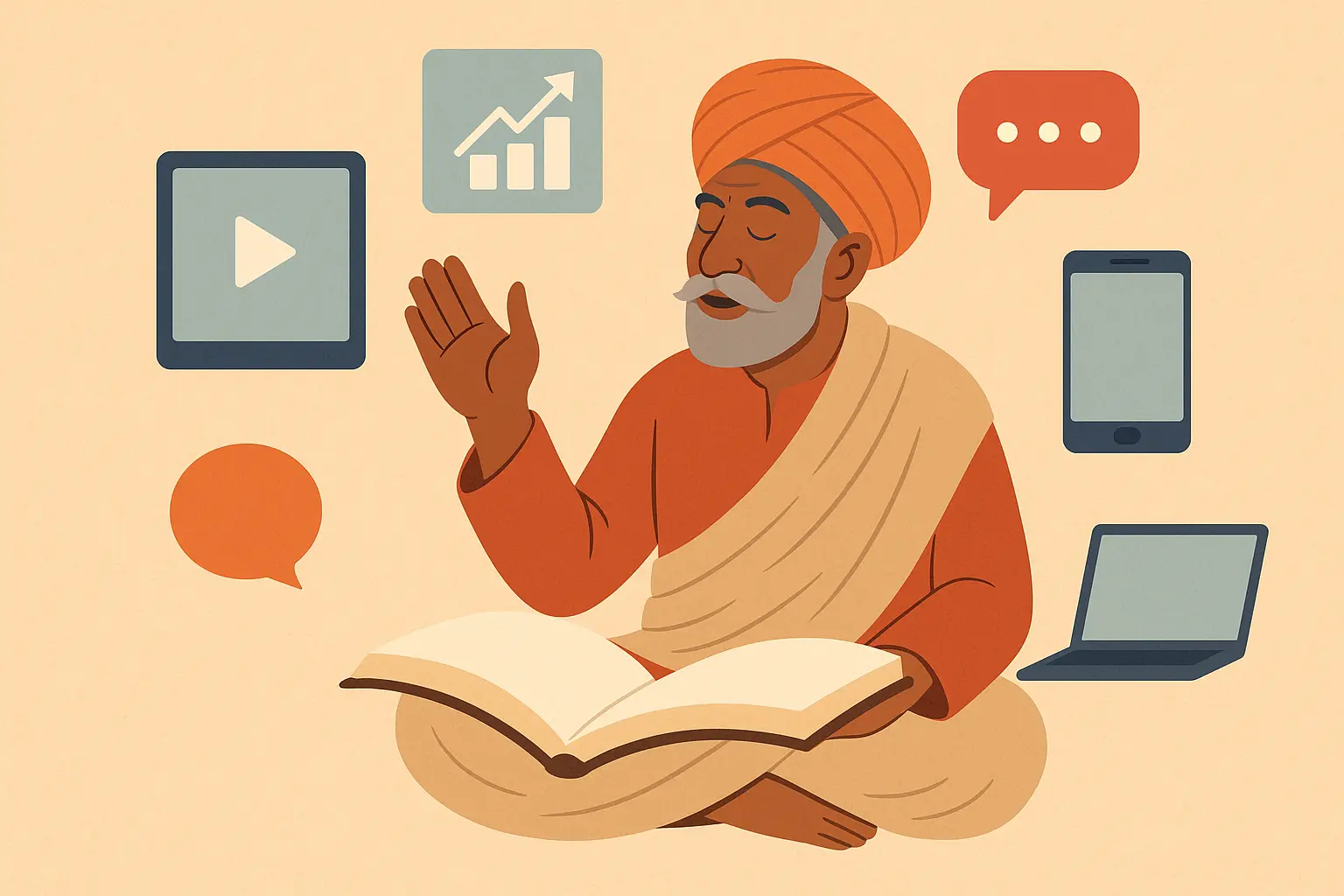I can still hear my grandmother’s voice echoing through our small living room, weaving tales of a clever advisor who could outsmart anyone with nothing but his wit. She’d sit in her favorite wooden chair, the one that creaked every time she leaned forward to emphasize a particularly good point, and transport me to the Mughal court where impossible problems had surprisingly simple solutions.
Back then, I just thought they were bedtime stories. I had no clue that decades later, I’d be sitting in a conference room thinking, “Wait a minute… this is exactly like that story about the crows!” when my boss asked me to “quantify our team’s creative output by next Tuesday.”
Turns out I’m not alone in finding these old tales surprisingly relevant. According to Rephonic’s podcast database, Akbar Birbal Stories podcasts have published 44 episodes over 5 years, showing that people are still hungry for this kind of timeless wisdom. These stories offer surprisingly modern solutions to challenges we face every day.

Table of Contents
-
Why These Stories Still Hit Different
-
How to Spot a Story Worth Your Time
-
Wisdom and Justice: 5 Stories That Teach Fair Leadership
-
Intelligence and Problem-Solving: 5 Tales of Creative Solutions
-
Humility and Human Nature: 4 Stories About Self-Awareness
-
Communication and Leadership: 4 Tales of Effective Influence
-
Creativity and Innovation: 4 Stories That Inspire Breakthrough Thinking
-
Ethics and Moral Reasoning: 3 Tales of Principled Decision-Making
-
Why These Stories Just Work
-
How Modern Storytelling Tools Can Enhance Your Narrative Skills
-
Final Thoughts
TL;DR
-
These 25 Akbar and Birbal stories span six categories that cover pretty much every workplace disaster you’ll ever face
-
Each story gives you actual tools for handling modern challenges while being entertaining enough that you’ll remember them when you need them most
-
The big lesson? Creative thinking beats “correct” answers when dealing with impossible problems
-
Birbal’s secret weapon was understanding people – their fears, motivations, and what makes them tick
-
You can use these approaches for everything from office politics to family disputes to that impossible project your client just dumped on your desk
-
Bottom line: good wisdom never goes out of style, no matter when it was written
Why These Stories Still Hit Different
You know that sinking feeling when someone drops an impossible deadline on you? “We need this done yesterday, but also make it perfect, and oh, the budget got cut in half.” I used to panic in those moments until I remembered how Birbal handled Emperor Akbar’s ridiculous requests.
Here’s the thing – Birbal never said “that’s impossible.” Instead, he’d reframe the whole situation. When my project manager asked me to “double our team’s productivity overnight” (yes, that actually happened), I channeled my inner Birbal: “I can definitely help you get the results you’re after. Let me show you three approaches that’ll deliver what you need within a realistic timeline.”
Boom. Suddenly we’re brainstorming solutions instead of arguing about impossibilities.
What really gets me about these stories is how spot-on Birbal was about human psychology. That story where he uses a pot of water to catch a thief? The guy basically invented lie detection centuries before we had the science to back it up. Guilty people get nervous, nervous people shake, shaking hands create ripples. Simple.
And don’t get me started on the blind men and the elephant – I swear this happens in every single meeting I’ve ever been in. Marketing sees the project one way, engineering sees it completely differently, and customer service has their own take based on user complaints. Everyone’s right from their perspective, but nobody has the full picture.
These 25 folktale story examples that demonstrate timeless narrative power all share this same quality – they give you frameworks that work whether you’re dealing with a Mughal emperor or your micromanaging boss.
Here’s what I’ve noticed about how Birbal’s approaches translate to modern life:
Impossible Tasks: Instead of explaining why something can’t be done, reframe it as “here’s how we can get you what you actually need”
Office Drama: Use psychology instead of confrontation – people reveal their true motivations when they think nobody’s watching
Different Perspectives: Get everyone in the same room looking at the same data before making decisions
Limited Resources: Find creative ways to use what you already have instead of asking for more budget
How to Spot a Story Worth Your Time
Not all Akbar and Birbal stories are created equal. I’ve read dozens over the years, and some are just “clever guy outsmarts emperor” without much substance. The good ones? They stick with you because they’re actually useful.
Stories That Actually Work
The best stories start with a problem that makes you think, “Oh man, I’ve been there.” Then they show you Birbal working through his thought process – not just pulling a solution out of thin air. You want to see the gears turning, so you can apply the same thinking to your own situations.
Take the mirror story – when Birbal tells Akbar he’s looking at the biggest fool in the kingdom. It’s not just a clever comeback. The lesson emerges naturally: we’re all capable of foolish decisions, and the wisest people are the ones who admit it. That’s not preachy – that’s just truth.
Stories You Can Actually Use
Here’s my test: after reading a story, can you think of three situations from your own life where you could apply the lesson? If not, it’s probably just entertainment.
The really good ones work across cultures and situations. The story about understanding limitations applies whether you’re a 16th-century scholar or a modern consultant who’s been overpromising to clients. Human nature doesn’t change much.
Stories That Make You Smarter
The stories I keep coming back to are the ones that don’t just give you answers – they teach you how to think. When Birbal figures out which woman is the real mother, he’s not using magic. He’s using psychology, understanding that real love prioritizes the beloved’s welfare over personal desires.
I actually used this principle when interviewing job candidates. Instead of asking hypothetical questions, I created scenarios where they had to choose between personal gain and team benefit. The people who chose the team? They’re still working with us three years later.

Wisdom and Justice: 5 Stories That Teach Fair Leadership
1. The Wise Judge
Okay, so picture this: two guys show up to court, both claiming the other one stole their gold coins. Both seem totally convinced they’re telling the truth. No witnesses, no evidence – just two people pointing fingers at each other.
Standard procedure would be a nightmare of he-said-he-said testimony that goes nowhere. But Birbal? He brings out a big pot of water with oil floating on top and tells both men to stick their hands in. He explains that the oil will reveal the truth through “divine intervention.”
Here’s what actually happened: the guilty guy was so nervous about being caught that his hands started shaking, creating ripples in the oil. The innocent guy stayed calm because, well, he had nothing to worry about.
I love this story because it shows how understanding people’s psychology beats aggressive questioning every time. The guilty merchant basically caught himself – Birbal just created the conditions for it to happen.
This reminds me of the same timeless wisdom in powerful anecdote examples that reveal truth through human nature. The best stories don’t just tell us what happened – they show us something true about how people really behave.
I’ve started using this principle in team meetings when something goes wrong. Instead of playing detective and making people defensive, I create situations where the truth naturally emerges. Works every time.
2. The Blind Men and the Elephant
This one hits close to home because I see it happen constantly. Several blind men encounter an elephant, and each describes it based on the part they touched. Trunk guy says it’s like a rope. Leg guy insists it’s like a tree trunk. Side guy is convinced it’s a wall.
They’re all arguing, each totally sure they’re right and everyone else is an idiot.
Sound familiar? That’s literally every project meeting I’ve ever attended. Marketing touches the “user experience” part and says we need more features. Engineering touches the “technical complexity” part and says we need to simplify. Sales touches the “customer complaints” part and says we need better support documentation.
Everyone’s right based on their limited perspective, but nobody has the complete picture.
I learned this lesson the hard way during a product launch that was failing spectacularly. Marketing blamed engineering for poor user interface. Engineering blamed sales for overpromising features. Sales blamed customer service for not handling complaints well.
Finally, I got everyone in the same room to watch actual users trying our product. Suddenly we all saw the same elephant – the product worked fine, but our onboarding process was confusing and our value proposition wasn’t clear. Once we shared the same perspective, the solution became obvious.
3. The Equal Division
Two women show up claiming to be the mother of the same baby. Both have compelling stories, both know details about the child’s care, both seem genuinely distressed. How do you possibly figure out who’s telling the truth?
Birbal suggests cutting the baby in half so each woman gets an equal share. One woman immediately agrees – “half is better than nothing.” The other woman screams in horror and begs them to give the child to her rival rather than hurt him.
Boom. Real mother identified.
The genius here is that Birbal created a test that revealed true motivations. Genuine love prioritizes the beloved’s welfare over personal desires. The real mother would rather lose her child than see him harmed.
I’ve used this principle in business situations more often than you’d think. When two department heads were fighting over budget allocation, I proposed cutting both their budgets equally and redistributing the money to other departments. The one who cared more about the company’s success than his own empire immediately offered alternatives. The empire-builder just got angry.
4. The Test of Honesty
Akbar needed a trustworthy servant but couldn’t tell which of three candidates was genuinely honest. They all had great references and said all the right things during interviews.
So Birbal set up a practical test. He placed a purse of gold coins along the path each candidate would take to their final interview, then hid where he could observe without being seen.
First candidate pocketed it immediately. Second candidate looked around nervously, then took it. Third candidate picked it up, examined it, and brought it straight to the court asking if anyone had lost it.
Guess who got the job?
This story taught me that character reveals itself when people think nobody’s watching. I once hired someone based partly on how they treated our receptionist when they thought I wasn’t around. That person turned out to be one of our best employees.
5. The Lazy Courtier
There was this guy at court who had turned excuse-making into an art form. Weather problems, other people’s interference, inadequate resources – he always had a creative explanation for why he couldn’t complete assignments.
Birbal gave him what seemed like a simple task: count every grain of sand on a specific beach and report back in a week. The courtier started confidently, probably already crafting his next elaborate excuse.
But after several days of actually trying, something clicked. For the first time, he came back and honestly said, “This is impossible. I can’t complete this assignment because it literally cannot be done.”
Birbal praised his honesty and explained that acknowledging genuine limitations shows more wisdom than crafting elaborate excuses for avoidable failures.
I keep this story in mind whenever I’m tempted to make excuses instead of just admitting I messed up or bit off more than I could chew. There’s a huge difference between legitimate constraints and convenient blame-shifting.

Intelligence and Problem-Solving: 5 Tales of Creative Solutions
6. Counting the Crows
This is my absolute favorite impossible task story. Akbar, probably having a slow day, decides to test Birbal by demanding he count every single crow in the entire Mughal Empire. We’re talking thousands of miles and millions of birds here.
Instead of explaining why this is ridiculous, Birbal confidently announces there are exactly 95,463 crows in the kingdom.
When Akbar (understandably) questions this oddly specific number, Birbal delivers the perfect response: “If you count more, those are obviously visitors from neighboring kingdoms. If you count fewer, some of ours are traveling to visit relatives.”
Brilliant, right? He created a logical system that could handle any possible verification attempt while maintaining his original answer.
I think about this story every time someone gives me an impossible deadline or an unrealistic request. The trick isn’t to focus on why it can’t be done – it’s to reframe the problem in a way that actually can be solved.
Last month, a client asked me to “guarantee” that their social media campaign would go viral. Instead of explaining why virality can’t be guaranteed, I said, “I can guarantee we’ll create content with the highest viral potential by using these proven engagement strategies. If it doesn’t perform as expected, those metrics will show us exactly what to adjust for even better results next time.”
Same confidence as Birbal, same reframing technique.
7. The Length of the Road
Akbar wanted to know the exact length of a winding mountain road that curved through forests and around hills. Traditional measuring would be a nightmare – all those curves and elevation changes.
Birbal grabbed a wheel of known circumference, marked it with chalk, and rolled it along the entire road while counting rotations. Multiply the rotations by the circumference, and boom – exact measurement.
What I love about this solution is how he found a simple tool that could handle complexity better than conventional methods. Sometimes the best approach isn’t the most obvious one.
This reminds me of a project where we needed to track user engagement across multiple platforms with different metrics. Instead of trying to create some complex unified dashboard, I found a simple tool that could capture the core behavior patterns we actually cared about. Way more effective than the elaborate system we originally planned.
8. The Pot of Wit
Jealous courtiers started spreading rumors that Birbal’s cleverness came from a magical pot rather than natural intelligence. They figured this would either discredit him as a fraud or force him to share his “secret.”
Instead of denying the pot’s existence, Birbal offered to sell it to the highest bidder. But here’s the catch – he warned that the pot only worked for people who already had natural wisdom. Without inherent intelligence, the pot would be useless.
The courtiers found themselves trapped: if they bid for it, they admitted believing in magic. If they had the wisdom needed to activate it, they wouldn’t need it. If they lacked that wisdom, it wouldn’t help them anyway.
This story cracks me up because it’s such a perfect response to people looking for shortcuts. There are no magic bullets for developing real skills – you have to put in the work.
I keep this in mind whenever someone asks about my “secret” for handling difficult clients or managing complex projects. There’s no magic pot. It’s just experience, practice, and learning from mistakes.
9. The Singing Donkey
A rival courtier thought he’d finally stump Birbal with an impossible challenge: make a donkey sing. Since donkeys only bray (and it sounds nothing like music), this seemed like a guaranteed failure.
Birbal brought a donkey to the courtyard and placed fresh food just out of its reach – close enough to smell, too far to access. The frustrated, hungry donkey started braying loudly and persistently.
“There,” Birbal announced. “The donkey is singing – a song of desire and frustration that expresses its natural voice.”
He explained that making any creature “sing” means understanding what motivates it to vocalize and creating conditions that encourage that natural expression.
This story taught me that seemingly impossible goals often become achievable when you understand the underlying motivations and work with natural tendencies instead of against them.
I used this principle when trying to get buy-in for a new process from a team that was resistant to change. Instead of forcing adoption, I created conditions where the new process solved problems they were already frustrated about. They “sang” its praises because it genuinely made their work easier.
10. The Invisible Cloth
Cunning merchants showed up claiming they had magical cloth that only wise and intelligent people could see. They pretended to weave and display this “fabric,” describing beautiful patterns while showing nothing but empty air.
Court members, afraid of appearing foolish, praised the cloth’s beauty and urged Akbar to buy it. The emperor was stuck – he saw nothing but didn ‘t want to seem unwise.
Birbal studied the situation and loudly praised Akbar’s exceptional wisdom in immediately recognizing the merchants’ deception. He explained that truly intelligent people see through such obvious frauds, while only fools fall for invisible cloth tricks.
This approach exposed the scam while letting everyone save face. The merchants were revealed as fraudsters, court members could claim they were testing the merchants’ honesty, and Akbar appeared wise for seeing through it all.
I’ve seen this exact scenario play out in corporate settings – someone presents a terrible idea with enough confidence that people go along with it rather than appear “negative” or “not a team player.” Sometimes you need a Birbal to point out that the emperor has no clothes.
What I’ve Learned from These Problem-Solving Stories:
-
Impossible deadlines: Create flexible systems that can accommodate any outcome
-
Resource constraints: Find simple tools that handle complexity better than elaborate solutions
-
Skills development: There are no shortcuts – put in the work
-
Motivation challenges: Work with people’s natural tendencies, not against them
-
Group deception: Sometimes someone needs to state the obvious truth

Humility and Human Nature: 4 Stories About Self-Awareness
11. The Greatest Fool
Akbar commanded Birbal to find the greatest fool in the kingdom. After weeks of “searching,” Birbal returned carrying an ornate mirror and presented it to the surprised emperor.
When Akbar saw his reflection and got a bit insulted, Birbal dropped this wisdom bomb: the greatest fool isn’t someone who lacks intelligence – it’s someone who refuses to acknowledge their own capacity for foolish decisions.
He explained that every person, no matter how smart or powerful, has moments of poor judgment. The truly wise recognize this limitation and stay humble. The mirror serves as a daily reminder that self-awareness beats false confidence every time.
I actually printed out this story and stuck it on my bathroom mirror after a particularly embarrassing mistake at work. It’s become my daily reminder that I’m perfectly capable of being an idiot sometimes, and that’s okay as long as I learn from it.
This wisdom shows up in story theme examples that explore human nature – the best narratives reveal universal truths about our shared humanity and capacity for growth.
12. The Proud Scholar
A visiting scholar wouldn’t shut up about his vast knowledge, claiming he could teach anyone anything and solve any intellectual challenge. The guy was insufferable, but since he was a guest, nobody could tell him to pipe down.
Birbal politely asked him to demonstrate his teaching abilities by instructing a donkey to read. The scholar immediately protested that this was impossible since donkeys lack the cognitive capacity for literacy.
“Exactly,” Birbal smiled. “You just demonstrated the most important aspect of true knowledge – understanding limitations and recognizing what cannot be accomplished.”
The scholar realized his earlier boasting had been completely exposed. Real expertise means knowing both what you can do AND what you can’t do.
I used to be that proud scholar, fresh out of college and convinced I knew everything. It took several humbling experiences (and a few spectacular failures) to learn that saying “I don’t know” is often the smartest thing you can say.
13. The Beautiful Garden
Akbar had created this elaborate royal garden with exotic flowers, fancy fountains, and rare plants from across the empire. He kept bragging about how it was superior to any other garden in the world.
Birbal suggested they visit a simple farmer’s plot outside the city. Akbar reluctantly agreed, probably expecting to see something that would make his garden look even more magnificent by comparison.
The farmer’s garden was just vegetables, herbs, and fruit trees – nothing fancy or decorative. But Birbal pointed out that while Akbar’s garden pleased the eye, this humble plot fed an entire family, provided medicine when they were sick, and generated income for survival.
Both had value, but the farmer’s practical garden served essential human needs while the royal garden served mainly aesthetic purposes.
This story hit me hard when I was obsessing over making my home office look perfect for video calls while neglecting the actual work I needed to do there. Sometimes function matters more than form, even if form gets more Instagram likes.
14. The Richest Man
When Akbar asked Birbal to identify the richest man in the kingdom, he expected some wealthy merchant with vast material possessions. Instead, Birbal presented a simple farmer who owned only a small plot of land and a modest home.
The farmer showed up in simple clothes, no gold or jewels. Akbar was confused – this guy was obviously poor compared to the empire’s wealthy merchants.
Birbal explained that this farmer slept peacefully every night without worry, felt grateful for his simple meals, enjoyed his work, and had no debts or enemies. He possessed something the wealthy often lacked: complete satisfaction with his circumstances.
The truly rich person, Birbal argued, has enough to meet their needs and feels content with what they possess. Material wealth without satisfaction creates poverty of spirit.
This story makes me think of a former colleague who made three times my salary but was constantly stressed, working 80-hour weeks, and envious of people making even more. After reading this story, she took a lower-paying job at a nonprofit that aligned with her values. Last time we talked, she seemed genuinely happier despite earning less.

Communication and Leadership: 4 Tales of Effective Influence
15. The Silent Message
A rival kingdom sent Akbar a mysterious gift – just a small pouch of various seeds with no message or explanation. The court was freaking out, with some advisors convinced it was a threat or curse.
Birbal studied the seeds and addressed the court with his interpretation. He said the message could be understood in two ways, depending entirely on Akbar’s response.
If planted with care, the seeds would grow into a beautiful garden, symbolizing potential for peaceful relations and mutual prosperity. If ignored or destroyed, they’d represent missed opportunities and possible future conflict.
Birbal advised sending back gardening tools and soil from the royal gardens, showing willingness to nurture friendship rather than suspicion.
The neighboring king was so impressed by this wise interpretation and generous response that he initiated a lasting alliance. Birbal transformed potential conflict into mutual benefit through positive interpretation and strategic response.
I think about this story whenever I receive ambiguous communication from clients or colleagues. Instead of assuming the worst, I try to respond in a way that encourages the best possible interpretation.
16. The Translator’s Dilemma
Two foreign merchants showed up with a heated dispute, but they spoke different languages that nobody in court could understand. No translator available, but both men clearly needed resolution.
Birbal watched their gestures, facial expressions, and the objects they carried. Through careful attention to non-verbal communication, he started understanding their disagreement – apparently a trade transaction gone wrong.
Using gestures, drawings in sand, and physical props, Birbal helped the merchants communicate with each other. He facilitated their conversation until they reached a compromise both could accept.
This approach shows the same cross-cultural understanding found in bedtime stories that work across different backgrounds – effective communication relies on universal human experiences rather than shared language.
I’ve used this principle in meetings where technical and non-technical team members were talking past each other. Sometimes you need to translate between different “languages” even when everyone speaks English.
17. The Angry King
Akbar was furious with a courtier who’d made a significant error that embarrassed the court. In his anger, the emperor threatened severe punishment and refused to listen to explanations.
Instead of directly challenging Akbar’s anger, Birbal told a story about a storm that encountered two trees. The rigid oak stood firm against the wind and was eventually uprooted. The flexible willow bent with the storm and survived intact.
He explained that great leaders sometimes need to bend rather than break when facing challenges. Rigid responses often create more problems, while flexible approaches lead to better long-term outcomes.
The parable helped Akbar recognize that his anger, while justified, might not produce the best results. He reconsidered his harsh punishment and instead created a solution that corrected the error while allowing the courtier to learn and continue serving effectively.
I keep this story in mind when I’m tempted to react emotionally to mistakes or setbacks. Sometimes the flexible response preserves relationships and creates better outcomes than the rigid one.
18. The Perfect Courtier
When Akbar asked Birbal to describe the ideal courtier, he expected a list of impressive credentials or political skills. Instead, Birbal painted a surprisingly humble picture.
The perfect courtier listens more than they speak, understanding that wisdom comes from learning about others’ perspectives rather than constantly promoting their own ideas.
They serve without expecting immediate rewards, finding satisfaction in contributing to the greater good rather than advancing personal interests.
Most importantly, they offer honest counsel even when it’s unwelcome, prioritizing the organization’s welfare over their own comfort or security.
Birbal emphasized character over credentials, service over self-promotion, and integrity over political maneuvering.
This description completely changed how I think about leadership and career advancement. The best leaders I know embody these qualities – they listen, serve, and tell the truth even when it’s difficult.
What These Communication Stories Teach:
-
Respond positively to ambiguous messages – encourage the best interpretation
-
Pay attention to non-verbal communication – sometimes actions speak louder than words
-
Stay flexible under pressure – rigid responses often make problems worse
-
Listen more than you speak – wisdom comes from understanding others’ perspectives

Creativity and Innovation: 4 Stories That Inspire Breakthrough Thinking
19. The Upside-Down Palace
Akbar was bored and challenged his advisors to create something completely unprecedented that had never been seen before. While others proposed elaborate but traditional solutions, Birbal conceived something wild – an entirely upside-down room.
He worked with craftsmen to create a chamber where furniture, decorations, and even a chandelier were securely mounted to the ceiling. The floor was covered with mirrors, creating the illusion that visitors were walking on the ceiling while looking down at an inverted world.
When Akbar entered this space, he experienced a complete shift in perspective – literally and figuratively. The room forced everyone to move carefully and think differently about space, orientation, and basic assumptions.
Birbal explained that true innovation often requires turning assumptions upside down and viewing familiar things from completely new angles.
This story reminds me of the best brainstorming sessions I’ve been in – the ones where someone says “What if we did the exact opposite of what everyone expects?” and suddenly breakthrough ideas start flowing.
20. The Musical Garden
Instead of adding conventional entertainment features like fountains or sculptures to a garden, Birbal designed a space that would create music naturally through wind interaction.
He selected plants with different leaf shapes and densities that produced distinct sounds when air moved through them. Bamboo groves created gentle percussion, while trees with hollow branches produced melodic tones.
Strategic placement of metal chimes, wooden wind instruments, and resonating chambers created a complex soundscape that changed with wind direction and seasonal variations. The garden literally composed different music depending on weather conditions.
This innovation combined botany, acoustics, meteorology, and musical composition into a single integrated experience that evolved over time.
I love this story because it shows how creativity often emerges from connecting seemingly unrelated concepts. The best solutions I’ve found usually combine ideas from completely different fields.
21. The Living Portrait
When Akbar commissioned a portrait, he expected a traditional painting. Birbal proposed something radically different – a living portrait that would capture the emperor’s character and achievements.
He organized theatrical performances where actors recreated key moments from Akbar’s reign – wise judgments, military victories, diplomatic successes, an
He organized theatrical performances where actors recreated key moments from Akbar’s reign – wise judgments, military victories, diplomatic successes, and moments of personal growth.
The “portrait” changed and evolved with each performance, allowing different aspects of Akbar’s character to be emphasized based on current events or audience needs. Unlike a static painting, this portrait could grow and adapt over time.
This approach captured something traditional portraits couldn’t – the dynamic nature of leadership and the multiple facets of a complex personality.
Birbal’s solution demonstrated that innovation often involves redefining the problem itself. Instead of creating a better painting, he questioned whether painting was the best medium for the intended purpose.
22. The Edible Architecture
For a grand feast, instead of focusing solely on the menu, Birbal proposed creating the entire dining environment from edible materials.
He designed temporary structures – pavilions, archways, and decorative elements – constructed entirely from various foods. Bread formed basic structural elements, while cheese, fruits, and vegetables created decorative details.
The edible architecture served multiple purposes: visual spectacle, practical dining surfaces, and interactive experience where guests could literally consume their surroundings as the evening progressed.
This approach solved several challenges simultaneously – aesthetic appeal, practical functionality, and resource efficiency – while creating a memorable experience guests discussed for years.
The innovation showed how creative thinking can address multiple objectives at once while eliminating waste and maximizing engagement.

Ethics and Moral Reasoning: 3 Tales of Principled Decision-Making
23. The Stolen Shadow
A distraught merchant approached court with the weirdest complaint ever – someone had stolen his shadow through supernatural means. The guy was genuinely distressed, claiming his shadow was shorter every morning and suspecting his neighbor of black magic.
The court was baffled, but Birbal took it seriously and investigated. He discovered the merchant had recently built a wall that blocked morning sunlight, causing his shadow to appear shorter than before.
Meanwhile, the accused neighbor had done nothing wrong – he just lived where the morning sun now cast longer shadows due to the changed landscape.
Birbal gathered both men and demonstrated how shadows work, showing how sun angle and surrounding structures affect shadow length throughout the day. He used this as a teaching moment about understanding natural phenomena before making accusations.
The merchant’s genuine distress made his accusation seem credible, but investigation revealed the true cause. This story shows how misunderstanding and fear can lead to false accusations, and how wisdom involves seeking evidence-based explanations before assigning blame.
I think about this whenever I’m tempted to jump to conclusions about someone’s behavior. Usually there’s a logical explanation that has nothing to do with malicious intent.
24. The Fair Trade
Two merchants appeared with conflicting claims about a trade gone wrong. Each accused the other of dishonesty and demanded compensation, presenting seemingly convincing evidence.
Through careful investigation, Birbal discovered both merchants had been partially dishonest. One had misrepresented his goods’ quality, while the other used false weights to shortchange the quantity.
Instead of declaring one guilty and the other innocent, Birbal created a solution where each merchant compensated the other for their specific deception. Both were held accountable for their contributions to the problem.
This approach taught that ethical problems often involve multiple parties with varying degrees of responsibility. Simple victim-and-perpetrator narratives frequently miss the complexity of real situations.
I’ve found this wisdom incredibly useful in workplace conflicts. Usually both parties have contributed something to the problem, and fair solutions require mutual accountability rather than one-sided blame.
25. The Generous Miser
A wealthy merchant had a reputation for extreme stinginess but publicly claimed to be generous, pointing to his occasional donations as evidence. His gifts were technically substantial but represented tiny fractions of his vast wealth.
Birbal organized an anonymous charity drive and observed as the merchant made a show of donating a large sum, expecting praise for his generosity.
But Birbal also noticed a poor widow who quietly donated a single copper coin – nearly all the money she possessed. Her tiny gift represented genuine sacrifice, while the merchant’s larger donation cost him nothing meaningful.
Birbal publicly praised the widow’s generosity while explaining that true giving involves personal sacrifice and comes from the heart rather than the wallet. The size matters less than what it represents to the giver.
This lesson transformed the merchant’s understanding of generosity. He began giving more thoughtfully, considering what donations meant to his own circumstances rather than just the amounts.
The story teaches that ethical behavior involves internal motivation and personal cost, not just external actions or impressive numbers.
Key Lessons from These Ethics Stories:
-
Investigate before judging – misunderstandings often look like malicious behavior
-
Fair solutions require mutual accountability – most conflicts involve shared responsibility
-
True virtue comes from the heart – it’s about sacrifice and intention, not just results

Why These Stories Just Work
What Makes Them So Darn Good
The strongest stories grab you immediately with problems that make you think, “Oh man, I’ve been there.” Whether it’s an impossible deadline, office politics, or trying to figure out who’s lying, these situations feel familiar despite happening centuries ago.
What I love about these stories is how Akbar isn’t just sitting there being impressed by Birbal’s cleverness. He’s learning, growing, and becoming a better leader. You can see the progression, which makes the stories more satisfying and shows that wisdom is actually transferable.
The plot structure stays tight and focused. Each story moves efficiently from “here’s the problem” through “here’s how Birbal thinks about it” to “here’s the solution and what we learn.” No wasted time or unnecessary complexity that might lose you.
The Stuff That Never Gets Old
The psychological insights in these tales are scary accurate by modern standards. Birbal’s understanding of how guilt creates stress responses, how pride blinds judgment, how fear leads to false accusations – it all aligns with what we know about human psychology today.
The emotional truths work across cultures and time periods. A mother’s willingness to sacrifice for her child, an honest person’s instinct to return lost property, a creative thinker’s ability to reframe impossible problems – these responses reflect universal human values that don’t change.
Social dynamics remain remarkably consistent. Workplace jealousy, leadership challenges, communication barriers, ethical dilemmas – every culture and historical period deals with the same basic human problems. These stories give you frameworks for understanding and handling persistent challenges.
How to Actually Use This Stuff
The workplace applications are everywhere. That diplomatic approach in “The Silent Message” works perfectly for international business negotiations. The creative problem-solving in “Counting the Crows” helps when clients make unrealistic demands.
For personal development, these stories build self-awareness, creative thinking skills, and communication abilities through engaging narratives that make learning enjoyable rather than boring.
The educational value goes way beyond entertainment. These stories develop critical thinking, emotional intelligence, and ethical reasoning through examples you’ll actually remember when you need them.

How Modern Storytelling Tools Can Enhance Your Narrative Skills
You’ve seen how Birbal’s creative approach to storytelling created narratives that people still find compelling centuries later. His ability to combine entertainment with education, develop memorable characters, and address universal human experiences gives us a template for effective storytelling that works today.
If you’re inspired to try your hand at storytelling – whether you’re sharing these tales with your kids, crafting presentations at work, or writing your own stories – you’re facing similar challenges to what Birbal encountered. How do you engage audiences, convey meaningful lessons, and create memorable experiences through narrative?
When You Hit Creative Blocks
Creative blocks happen to everyone, just like impossible challenges confronted Birbal regularly. When you’re stuck on plot development, character motivation, or how to make your point without being preachy, AI-powered tools can provide fresh perspectives to move forward.
These tools excel at generating alternative approaches when conventional methods aren’t working. If your story feels predictable or your characters seem flat, AI can suggest unexpected plot twists, character backgrounds, or thematic elements that add depth and interest.
The key is using these tools as creative partners rather than replacement writers. Just like Birbal combined his natural wit with careful observation and creative thinking, effective storytellers blend AI suggestions with their own insights and experiences.
Creating Characters People Remember
Character development requires understanding human psychology and motivation – skills Birbal demonstrated consistently. Modern AI tools can help you explore character backgrounds, motivations, and personality traits that create the same depth and relatability.
These systems can generate detailed character histories, suggest personality conflicts that drive plot development, and help you understand how different character types might react to various situations.
The goal isn’t to replace your creative judgment but to expand your options and help you consider possibilities you might not have explored independently. Strong characters drive compelling narratives, just like Birbal’s wit and Akbar’s wisdom create the foundation for their enduring stories.
Making Stories That Work for Everyone
Universal appeal requires understanding fundamental human experiences and emotions that remain constant across cultures and time periods. AI tools can help identify these universal themes and suggest ways to incorporate them into your narratives.
These systems can analyze successful story patterns, suggest thematic elements that resonate broadly, and help you balance cultural specificity with universal relatability. The goal is creating stories that feel both authentic to their setting and accessible to diverse audiences.
Whether you’re developing short story examples with universal themes or crafting modern narratives inspired by these classic tales, AI tools can help identify narrative structures that create lasting impact.
Nairrate’s AI story generator specifically addresses these storytelling challenges by combining advanced language processing with deep understanding of narrative structure. Whether you’re crafting modern parables inspired by these classic tales or developing entirely original narratives, the platform serves as your creative companion in transforming initial ideas into compelling stories that capture imagination and hold attention.
Ready to enhance your storytelling skills with AI-powered assistance? Try Nairrate’s story generator and discover how modern technology can help you create narratives with the same timeless appeal that has made Akbar and Birbal stories beloved for centuries.

Final Thoughts
The thing that keeps bringing me back to these stories is how they prove that human nature really doesn’t change much. Whether you’re dealing with impossible deadlines, trying to figure out who’s telling the truth, or navigating office politics, the same psychological principles that worked in Akbar’s court work in today’s world.
What makes these narratives particularly valuable is how they show that the best solutions often come from reframing problems rather than finding conventional answers. Birbal’s approach to counting crows, creating upside-down palaces, and resolving disputes through psychological insight demonstrates that breakthrough thinking requires questioning assumptions and exploring unconventional approaches.
These stories also remind me that true leadership involves serving others, staying humble despite success, and communicating effectively across different perspectives and backgrounds. These lessons apply whether you’re managing a team, raising kids, or just trying to handle daily interactions with more wisdom and compassion.
My grandmother would probably smile knowing these old tales are still helping people figure things out. Next time you’re stuck on a problem that seems impossible, ask yourself: What would Birbal do? Chances are, the answer involves getting creative, understanding human nature, and maybe turning the whole situation upside down to see it from a new angle.
The wisdom embedded in these ancient tales proves that good advice never goes out of style – it just gets passed down through generations of grandmothers telling bedtime stories to kids who don’t realize they’re learning life skills that will serve them decades later.



Add comment